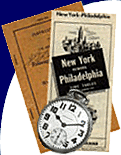

| home | articles | briefs | classifieds | flimsies | interchange |
 |
 |
||||||
|
|||||||
 |
RyPN Briefs December 20, 2006 previous brief ~ return to briefs index ~ next brief Book Review: ''Advanced Steam Locomotive Development, Three Technical Paper'' by L. D. Porta, Consulting Engineer, Camden Miniature Steam Services, UK, 100 pages, softbound Seldom have I seen such a wealth of information in as small a book. Long after N. America and Europe had abandoned steam locomotion, Livio Dante Porta continued to pursue development of the technology as a practical solution to real transportation needs in the low-tech environment found in many developing nations. The three of his papers included in this volume demonstrate his real-world, practical approach as a hands-on railroader, as well as his exceptionally wide and deep academic grasp of the possibilities inherent in applied thermodynamics - provided "Good Enough Engineering" isn't the accepted appropriate standard. The first paper (1969) outlines the historical development to that date of steam power in Argentina - Porta's home country. Porta outlines how continued technological innovation applied to the existing fleet of traditional steam locomotives, even in the rather basic engine shed conditions in that country, resulted in performance and economy unequaled, on a ton-for-ton basis, by the best Superpower Lima ever built in its much more advanced facilities. It isn't a recipe book - only a modicum of technical and test data for each example is provided, as the purpose of the paper is an overview rather than a case study. The conclusion of Porta's remarks is a thumbnail proposal for a new generation steam locomotive design. The paper concludes with commentary by other members of the Institution of Locomotive Engineers, and Porta's response to their comments. I was struck by the extremely practical and attainable alterations outlined in the paper, and the economies which resulted - most of which could be of significant interest to steam tourist railroad operators in the developed world today. The second paper (2000) is a very deep technical proposal for a new system of compounding steam locomotives. Porta begins by discussing steam cylinders and various associated phenomena as they go about doing their work for better or worse - with a great deal of data, including indicator diagrams, to illustrate. Various types of compounding are considered, along with various valves and other hardware, resulting in a proposal for a new small compound engine for the Ferrocarril Austral Fuegueno (FCAF). Of the three papers, this probably provides the least immediately applicable information for those working on existing steam locomotives in the developed world, but provides a wealth of very detailed information for anybody contemplating building a new one. The third paper (1999) is a short and very pointed explanation of the reality of a simple and pervasive condition that is much more accepted and costly than it should be - steam leakage. Using a newly-built, old-technology locomotive from a tourist line in Tierra Del Fuego as a case study, Porta relates some historical data concerning steam leakage to the measurements made in the case study, and explains what alterations were made which resulted in greatly improved performance and economy. All this information can be immediately applied to benefit any operating steam locomotive today. Bracketing these papers is introductory and explanatory matter, a brief biography of Porta, and an article about the locomotive named for him on the FCAF. This is the "How to Make Your Engine Better" book every steam operator should read. It can be ordered from Camden by email at |
|
Copyright © 1998 thru 2024, all rights reserved, contents may not be used without permission. |